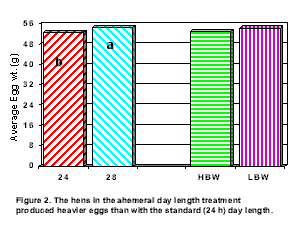| | Definition
Ahemeral day - a day that has more or less than 24 hours.
Introduction
Long ahemeral days are greater than 24 hours in length. Because some hens require more than 24 hours to lay an egg, longer (ahemeral) day lengths should allow hens to lay an egg a day for more consecutive days without a pause.
The obvious trade-off with long ahemeral days is that the total number of days per week decreases. Instead of a regular week with seven 24 h days, an ahemeral week may consist of six 28 h days. 100% production (an egg per day) in a 6 x 28h week would be equivalent to 85.7% production in a standard 7 x 24h week. This would reduce the maximum rate of lay to 6 eggs per week rather than 7 eggs per week.
Typically, the first egg laid by broiler breeder pullets is smaller than the minimum size required by hatcheries. However, long ahemeral days result in an increase in egg size early in lay which may result in an overall increase in the total number of settable eggs. Previous research has shown that shell quality (measured by specific gravity) improved with long ahemeral days. Increases in hen housed egg production have not been consistent.
The objectives of this experiment were to determine:
1. whether egg size can be increased in young broiler breeders through the use of long ahemeral days from 22 to 30wk of age,
2. whether egg weight increase is due to an increase in yolk weight, albumen weight or shell weight,
3. the effect of this photoschedule on ovarian and carcass morphology at 30 wk of age.
Materials and methods
Sixty-four Shaver Starbro broiler breeder pullets were caged in individually lit layer cages at 21 wk of age. Thirty-two pullets had a slightly high BW (HBW) and 32 had a slightly low BW (LBW). There was a 460 g difference between the HBW and LBW pullets.
At 22 wk of age, 32 birds (16 HBW and 16 LBW) were exposed to a typical 24 h day, 14L:10D, and the remaining 32 birds (16 HBW and 16 LBW) were exposed to a long ahemeral day 14L:14D (28 h). The 24 h birds were fed on 7 d wk and the 28 h birds were fed on 6 d wk. The total amount of feed for a week was the same for each treatment.

The production of normal and defective (without an intact shell) eggs was recorded daily (7 times a week for the 24 h day {hemeral} hens and 6 times a week for the ahemeral hens) for each hen. Laying records were used to determine total egg production, total settable egg production, number of ovulations, and percentage of defective eggs.
The time of lay for each egg was recorded by a personal computer (PC). Each egg was weighed and broken open to determine the weight of its components (yolk, albumen and shell). At 30 wk the birds were killed by cervical dislocation in order to study ovary morphology and carcass characteristics. The hens were weighed and dissected to determine weights of breast muscle, abdominal fat pad, liver, intact ovary, stroma and oviduct. Shank length, and the number of large (greater than 10 mm) and small (greater than 5mm but less than 10mm) yellow follicles was also recorded.
Results and conclusions
Total egg numbers did not increase with the 28 h day (24 h=25.4 eggs;28 h=23.1eggs) over the 9 week trial period (Figure 1). The 24 h hens laid more double yolked eggs (0.9% of total egg production) than did the 28 h birds (0.3%).

Egg formation time was consistently longer for the 28 h hens (26.8 h at 25 wk of age and 25.8 h at 29 wk of age) compared to the 24 h hens (25.4 h at 25 wk of age and 24.8 h at 29 wk of age). Egg weight was higher for the 28 h birds (55.1 g) compared to the 24 h birds (53.0 g) (Figure 2).
Egg shell quality (as indicated by specific gravity) was higher in eggs from all 28 h hens than from the 24 h hens. The increase in egg weight between the 28 h and 24 h birds was due to shell weight. Absolute and proportional weights of the egg shell were 5.5 g and 10.0% of the total egg weight for the 28 h birds, and 4.9 g and 9.3% for the 24 h birds, respectively.
While egg size can be increased with the use of a long ahemeral days early in lay, this may be at the expense of total settable egg numbers.
A. A. B. Spies, F. E. Robinson, R. A. Renema, J. J. R. Feddes, M. J. Zuidhof, and R. C. Fitzsimmons
University of Alberta
Poultry Research Centre News - Vol. 8 No. 2, May 1999 |
|